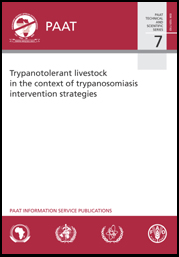 |
PAAT TECHNICAL
AND SCIENTIFIC SERIES 7
Trypanotolerant livestock
in the context of trypanosomiasis
intervention strategies
Kwaku Agyemang
International Trypanotolerance Centre
Banjul
PAAT INFORMATION SERVICE PUBLICATIONS
|
| |
|
|
FOOD AND AGRICULTURE ORGANIZATION OF THE UNITED NATIONS
Rome, 2005
|
| |
Table of Contents
|
The designations employed and the presentation of material in
this information product do not imply the expression of any opinion whatsoever
on the part of the Food and Agriculture Organization of the United Nations
concerning the legal or development status of any country, territory, city or
area or of its authorities, or concerning the delimitation of its frontiers or
boundaries.
ISBN 92-5-105262-X
ISSN 1020-7163
All rights reserved. Reproduction and dissemination of
material in this information product for educational or other non-commercial
purposes are authorized without any prior written permission from the copyright
holders provided the source is fully acknowledged. Reproduction of material in
this information product for resale or other commercial purposes is prohibited
without written permission of the copyright holders.
Applications for such permission should be addressed to:
Chief
Publishing Management Service
Information Division
FAO
Viale delle Terme di Caracalla, 00100 Rome, Italy
or by e-mail to:
[email protected]
© FAO 2005
Contents
Abstract
Acknowledgements
Acronyms
Chapter 1.
INTRODUCTION
Objective of the study
Approaches and methods adopted in the
study
Chapter 2. REVIEW OF LIVESTOCK
AGRICULTURE IN THE CONTEXT OF TRYPANOSOMIASIS
Overview of the political and
agricultural economy of West and Central Africa
Livestock in the agricultural and
rural economy
Trypanotolerant livestock and their
productivity
Trypanotolerance and the future of
agriculture in West and Central Africa
Government restrictions on movement of
trypanotolerant stock: the embryo transfer experience
Chapter 3. OVERVIEW OF METHODS FOR
TSETSE-TRYPANOSOMIASIS CONTROL OR ERADICATION
Chapter 4. PERTINENT ISSUES IN
DESIGNING ANALYTICAL FRAMEWORKS
Changes in ecological
settings
Agro-ecological zones and production
systems
Livestock production systems in
tsetse-affected areas in West Africa
Trypanotolerant livestock in changing
physical and market environments
Valuation of trypanotolerant
livestock
Trade in trypanotolerant livestock in
relation to expansion of herd size
Supply and demand fortrypanotolerant
stock
Distribution of trypanotolerant
livestock and trends in herd size
Utilization
Conservation
Scientific breakthroughs in
chemical-based technologies for trypanosomiasis control and selective breeding
programmes
Chapter 5. FRAMEWORK FOR ANALYSING
THE ROLE OF TRYPANOTOLERANT LIVESTOCK
Chapter 6. DISCUSSION AND
CONCLUSIONS
REFERENCES
BACK COVER
